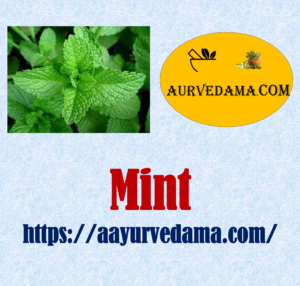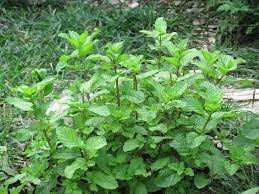Mint
Mint plant in other languages – Hindi, Marathi – Pahadi Pudina, English – Spearmint, Garden mint, Lamb mint, Green mint, Latin – Mentha spicata, Men. Viridis, Min. Spicata type Viridis Cul-Labiaceae or Lamiaceae. A familiar common medicinal [aushadhi] plant. The total number of women in the race of her classical name Mentha. 25 species are widespread, all aromatic and found mainly in temperate regions except the Americas. Many varieties have been introduced in other countries and are found in cultivation. In India Six species are found. Overall there is a lot of diversity in the species and there are many hybrids and varieties due to interbreeding. Some are cultivated in gardens and fields as they are less useful, all are commonly called pudina in Marathi, but there are differences between them.

Mentha spicata: This variety of mint is smooth, perennial (living for many years), Su. 30–90 cm. Tall and U. It is native to England but is cultivated worldwide. Planted in gardens and horticultural fields in India. It has a slender trunk (Mulkshod) growing horizontally in the ground and from it many quadrangular branches (Aghashrach) grow on the ground. Leaves are simple, opposite, smooth, sessile, lanceolate-ovate, pointed, toothed and have pubescent (glandular) hairs on the underside. At the tips of the branches and in the axils of the leaves are corn-type inflorescences with small clusters of bluish flowers [punjavalari pushpabandha] on the axils. The corolla is 4-5-parted and the fruit (mudrika) is dry and very fine, with one fine seed in each of its four sepals. It is surrounded by the ever-present samvarta. Other general physical characters and floral structure are as described in the Labiate clan (Tulsi clan).
Must read – Pimple ( Peepal tree )
In this caste. rotundifolia and Men. Longifolia is made up of hybrids and further cultivars, so there is a lot of variety. Cultivated as a vegetable everywhere in India, it thrives well in loamy and fertilized soil. Branches of old (previously existing) crop trunks and branches Su. 30 cm. The distance between two pieces in a shower is approx. 15 cm. keep Water needs to be given in rough weather and weeds need to be removed sometimes. Although leaf removal once or twice a year can continue for a few years, replanting every year is essential for good yields. 460 cm before planting to avoid tambera disease. After keeping the pieces in warm water for ten minutes, they are planted.

Mint leaves are used for flavoring in cooking. Peppermint is stimulant, carminative and antispasmodic. The leaves are used to make sedative (soothing) tea as well as an alcoholic drink from the leaves and given as an antidote to poisons. Peppermint sprig [aushadhikalpa] is added with sugar for hysteria and nausea in pregnancy and complaints of children, and peppermint is also effective against fever and bronchitis. The leaves have a distinct aroma and somewhat pungent taste. Leaves contain water 83·01, protein 4·8, fat 0·6, carbohydrates 8·0, fiber 2·0, minerals 1·6. Besides carotene 2·700 A.A. (International Units), Nicotinic Acid 0·4 mg., Riboflavin 10 mg. (1 mg. = 10-6 grams) and thiamine 50 mg. etc.
Read also – Parijataka ( Night Jasmine )
Distillation (the act of separating the components by steaming and then cooling) from the fresh flowering plant yields 0·25–0·50% volatile oil (spearmint oil). It is slightly yellowish or greenish or greenish and has a distinct aroma and taste of mint. Older oil has a better smell. l-Caravan is a specific component of the oil and its amount varies in different oils. American spearmint oil is extracted from Scotch mint (Mentha cardiaca). Russian oil is extracted from another (Mentha verticillata) variety. American spearmint oil is added to chewing gum, toothpaste, confectionary, and medicine. This oil has not yet attained commercial importance in India.

Mentha arvensis : (Ing. corn mint, field mint). This variety of Indian mint is temperate. Found in Asia up to the Himalayas and in Europe. It is common in Kashmir (up to 1,500–3,000 m altitude) in wild state and around Gulmarg. It also appears sporadically in some other okani but is nowhere widely cultivated. It is straight 10-60 cm. Leaves simple, 2·5–5 cm tall. Organs vary, being long, sessile or very short-stalked, obtuse-ovate, toothed and wedge-shaped at base, and somewhat hairy or glabrous. Clusters of small bluish flowers appear in the axils of hila leaves, at the top of the stem. Some other symptoms are as given in the genus Labiati. It is hybridized with many other breeds and various hybrids are found. It is used locally for medicine. It is stimulant and carminative and treats indigestion and rheumatism. Menthol is not isolated from the oil of its leaves (when cooled) and the oil does not come in official quality.
Like to read – Pangara
Benefits of Mint or Uses of Mint
Drink mint tea to cure headache.
Headache is often caused due to digestive disorders. Peppermint tea can be very beneficial in such situations, as it has digestive properties that help in proper digestion of food which strengthens your digestive system.
Mint is beneficial in hair loss
Mint reduces hair dryness due to its properties. This reduces hair fall and breakage, allowing hair to grow naturally. Regular consumption of mint will reduce hair loss.
If there is indigestion
An upset stomach often leads to indigestion. Take 100 ml juice of lemon, mint and ginger in this. Add 200 grams jaggery to it. Preferably cook in a silver pan. Take this little by little in the amount of 20 ml. This eliminates the problem of indigestion.
Use to treat fever in fever
Drink mint leaf decoction for fever due to change of season. It cures fever. Apart from this, making mint chutney and feeding it also cures fever and prevents loss of appetite due to fever. Medicinal properties of peppermint help in quick relief from fever.
Benefits of mint for earache
Sometimes, cold or water in the ear causes pain in the ear and putting mint juice in the ear gives relief in the case of ear pain. Extract the juice of mint leaves and put 1-2 drops of it in the ear.
Mint leaves heal mouth ulcers
Make a decoction of mint leaves on sores i.e. red sores in the mouth and pain. Swallowing it reduces mouth sores.
Benefits of mint in toothache
Brushing his teeth with powdered mint leaves eases toothache. Medicinal properties of mint help in reducing toothache. The benefits of peppermint help a lot in reducing pain.
Mint is beneficial for sore throat
When the weather is cold, the pharynx often swells and then for relief from sore throat, make a decoction of mint leaves and take 10-15 ml, it reduces swelling of the throat. You can also take mint syrup available in the market.
Benefits of Mint to Increase Appetite
Sometimes due to medicine, or due to a long illness, the appetite decreases. If you are suffering from this problem, take 6 grams each of tree material, mint, suk aal, along with 50 ml of pomegranate juice. Along with this, take 3 grams of pippali, 1 gram of cloves, 3 grams of big cardamom, 18 grams of rock salt and 35 grams of cumin seeds. Add equal amount of sugar to it. Make a powder of it. Add 1-5 grams of it to water and drink it. This eliminates the problem of lack of appetite. If you are not hungry, you can make mint chutney and eat it.
Source – Marathi vishwakosh
Read more –